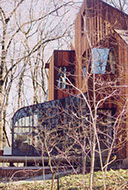
Preface to My Published Prefaces
ReadMe --
 California Redwood House in An Ohio Maple Forest
California Redwood House in An Ohio Maple Forest
The textures – weathered, stained redwood against arching glass masses; those against geometric red brick, the patios, against ragged flagstone and exposed aggregate concrete paths. And the intricacy of dense woods, lacy Spring leaves and strong-willed trunks, the monolithic gold wall of Fall sugar maples, playing against these simple structural forms. That’s outside.
Inside, the simple pure white or taupe walls...

The Inside Passage: Art Photographs
So here we are, the four of us, in the Prego Room again, at our favorite table. Oh goodness! Look at those peaks moving by, those clouds, those compositions! Oh, I’ve got to get this! “Excuse me, folks.” And I pop up and am away. Just a pop-up away from magnificent peaks, clouds, compositions, table and sommelier, a cruise venue is the most marshmallow artistic experience an artist could dream of.

An Oeuvre of Oil Portraits
This is a book of portraits in oil painted by a physician, me. That’s not quite as odd as oil paintings by Hitler, but odd enough to warrant a preface, pages of preface, in lieu of my memoirs, such as all my octogenarian friends are writing.
Medical school was my de facto art school, and the seminar my atelier, where I studied art as earnestly as any expatriate American in 19th century Paris. Strong on facial expression and weak on Michelangeloean musculature and let-it-all-hang-out creativity, my art school curriculum was not classical.
This ReadMe is a preface to certain prefaces that I have written, and, better yet, a place to plug in, just for the fun of it, an essay on prefaces and the sort of person who would write that sort of thing, besides writers hungry enough to write anything, even prefaces. For some reason I enjoy writing them. I'm hungry for them. Footnote: for present purposes a foreword and a preface are the same. Ordinary books are as likely to have a foreword as a preface. Here, preface.
An “introduction” is different. It presents in miniature what is going to be presented in full-monty detail in the book or article, and is what is found in technical or academic tomes, especially syllabi (“The student will acquire a knowledge of…”). A preface, or foreword, teasingly withholds details. Instead it gets you into a mood of what’s coming.
A “summary,” whether as caboose to the book itself or published elsewhere, tells what a book or article is like and whether to bother with it, and most people check either the introduction or the summary first. You should, I think, read the preface before the summary or the critique.
So at this point, please welcome, or duck or cringe at, the Critique. If a book is happily fathered by a preface, it draws flies of the species Critique!
Prefaces (or forewords or introductions or summaries) and critiques are different animals, as different as a friendly enteric bacteria living in your colon and a cholera vibrio you wouldn’t want near your colon.
Both prefaces and critiques exist only because other writings exist. A preface is symbiotic, imparting energy and tone to the book and the book feeding off the preface. The critique is parasitic or saprophytic, depending on whether the substrate is alive or dead. If the book isn't already dead, the critique may do it in. A preface may make the book happy to be alive. A critique may ruin a book's day.
The preface marches before the book like a drum major before the band marching before the parade. I see the preface as the maître d' or warm-up act, to get you into a happy mood and your juices going. A critique gets juices going too, but different juices. Heartburn juices.
A critique can’t live in the book, by court order, maybe. They’re divorced and the critique is out to get custody of the kids and the Mercedes. That’s not me.
A preface writer is a kindlier soul – that’s me! -- comfy in robe and slippers, like Alistair Cooke welcoming you to Masterpiece Theater.
I’m not a big fan of fiction and there’s less fiction in prefaces than in novels or, I've got to say this, critiques, but enough. Metaphors apPeale to me more than plots, and a preface is an even stronger metaphor for life than any novel, however touted as the consummate medium to express the human condition. What is life but preface! And a foreword commands, "forward march!"
Yet it is the critic pounding the table who inherits the earth, not the meek and pacific preface writer. In the Golden Age of all those Golden Ages, the critic was the tuxedoed and bewigged judge of creative thought on Broadway and Hollywood, canvas and paper. Ruskin ruled the arts; Adam Gopnik ruled Singer Sargent. Louella Parsons was to the creative world as Ralph Nadar to the Corvair, as Peter the Great to the serfs. Roger Ebert’s thumb is more powerful than any hand rocking a cradle. Critics are even more venerated than novelists, and both dismiss and diss the preface writer. Critiques infest Amazon. Nary a preface.
Everybody wants to be a critiquist, nobody a prefacist. Nobody (I'm an exception) reads prefaces, ever, anyway, even when C.S. Lewis or John Updyke write them. Almost all writers moan of being readerless, but nobody is more readerless, nobody writes more for himself only than the writer of prefaces.
Preface, foreword, introduction? Beloved of octogenarians and librarians, unknown to smartphone texters, those devices are as out of date as the landline phone, which, ahem, is still my main phone, which says something about me. But this is the e-Era, and the whole planet and every outstretched palm are being papered over by screens created by a whole new geeky-whimsical kind of brain, which dreamed up the pixel-gutted crash, trash, and password, and the README.
So I’ve just got to critique it: README sounds whimsical and whiny, bullying and bossy, bratty, self-centered and stuck-up; a huffy baby bird shrieking feed me! The #hashtag of the thumb-texting-sucking generation. LIKE? Please configure your browser to keep this cookie.